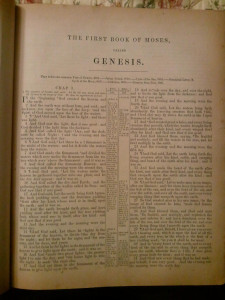I am excited to announce the completion of our first Bible Info Graphic. It is the first in our Journey Through James series. You can view the info graphic by clicking on the link below. We plan to make all of our info graphics available for free on our website. Until then, stay tuned!
Fascinating Fossil Discovered… In a Museum
According to several recent articles, a fascinating fossil was recently discovered in a German museum – of all places. The fossil is causing quite a stir because of its snake-like body with four distinct limbs. In fact, its scientific name, Tetrapodophis amplectus, loosely translates as “four-legged, hugging snake.”

Of course, a lot of controversy surrounds the finding. For instance, not all the scientists are convinced it is a snake. Michael Caldwell, a paleontologist at the University of Alberta in Edmonton, Canada, had this to say:
I honestly do not think the fossil represents the remains of a snake. It completely lacks key features of the vertebral column that would make it a squamate [scaled reptile] and more specifically a snake. If the rest of the animal is not a squamate, then teeth do not make you a snake.
And there is also the debate between the evolutionists and creationists.
And the Lord God said unto the serpent, Because thou hast done this, thou art cursed above all cattle, and above every beast of the field; upon thy belly shalt thou go, and dust shalt thou eat all the days of thy life: and I will put enmity between thee and the woman, and between thy seed and her seed; it shall bruise thy head, and thou shalt bruise his heel. Genesis 3:14-15
To read more about this recent discovery, read here:
1,500 Year Old Charred Scroll Deciphered!
The Israeli Antiquities Authority has announced that a charred scroll dating back 1,500 years has been deciphered. Guess what they found? If you guessed a Biblical text, you’re right.

The scroll was found in a synagogue at the Ein Gedi site near to where the Dead Sea Scrolls were found in some caves. Archaeologists have dated the scrolls around 500 A.D., making them the oldest Biblical text next to the Dead Sea Scrolls. What the charred scrolls contained had been a mystery for some time. But thanks to CT scans and some modern, digital-imaging software, researchers with the University of Kentucky were able to read a passage out of the book of Leviticus. It is the first time that archaeologists have found a Torah scroll in a synagogue.
You can read about the full discovery here:
Couple Finds Ancient Ruins Under the Floorboards
Only in Jerusalem can one find 2,000 year old ruins under the living room floor – as one couple recently unveiled. A mikveh was a ritual pool of water where one could cleanse oneself both symbolically and physically. It was a practice that was very common among devout Jews during the time of Christ – particularly those among the Essene communities.
This find, in a section of Jerusalem commonly called Ein Kerem, is important because it validates an Essene presence in the heart of the city. The Essenes for many centuries were thought to have lived only in sheltered monasteries in the wilderness. There are many traditions in Israel that have identified John the Baptist and his family as being a part of these Essenes in Jerusalem. You can read the full story of the find here:
http://www.ksl.com/?sid=35329486&nid=968&fm=home_page&s_cid=toppick4
Tomb of the Queen of Sheba Discovered!
Earlier this year, archaeologists discovered what they believe to be the tomb of the Queen of Sheba, an ancient Biblical character shrouded in mystery.
Professor Joseph Yang of Oxford University led a team of archaeologists in the discovery of the tomb in Northern Yemen near the capital city of the ancient kingdom of Saba. You can read the full article of the discovery here:
http://worldnewsdailyreport.com/archaeologists-discover-tomb-of-biblical-queen-of-sheba/
Professor Yang lists several reasons why he believes this to be the tomb of the ancient queen:
“The carbon-dating, the location, the inscriptions, the characteristics of the skeleton and the nature of the artefacts on the site all seem to confirm that the bones are indeed those of the famous queen regnant who visited Salomon. The tomb is located just outside the ruins of Ma’rib, the ancient capital of the kingdom of Saba or Sheba, and many inscriptions in the tomb refer to “Bilqīs,mqtwyt of Sheba’ which means Bilkis, high chieftess on Sheba. All the evidence we have found until now seems to suggest that this is indeed the biblical queen of Sheba.”
Rare Inscription Found!
The Israel Antiquities Authority (IAA) just announced this past Tuesday that a rare inscription has been found inscribed on a clay jar near the site of David’s famous battle with Goliath. The name was that of one of Saul’s sons and a rival of David’s for the throne. Here is a link to the article:
http://news.discovery.com/history/archaeology/rare-inscription-bearing-biblical-name-found-in-israel-150616.htm
The Valley of Elah was one of my favorite places when we visited Israel. It is relatively quiet and peaceful; and very rural. I remember finding handfuls of little clay pieces from pottery that was very old. It was very enjoyable to visit. We also climbed up a very steep hill where the army of Israel was hiding from the Philistine giant. At the top pf the hill was a very old, stone altar. We also gathered smooth stones from the creek bed below to take back with us!
A Journey Through James Post 3 “Nazareth, Home of the Just”
 As mentioned earlier, James was the oldest son of Joseph and he lived much of his early life in Nazareth. There is much we can learn from this historical fact. Around 100 years before the birth of Christ, a small clan of Davidic descendants migrated back to Israel from the Babylonian exile. They formed two small villages on either side of the Jordan River: Kochaba, which means village of the star, and Nazara, which means village of the shoot. These descendants of David were very Messianic, believing that Israel’s deliverer would indeed come from their ranks. They refused to marry outside of the Davidic line and they kept very detailed genealogies. Those found in the Gospels of Matthew and Luke were doubtless provided by members of Christ’s extended family in Nazareth.
As mentioned earlier, James was the oldest son of Joseph and he lived much of his early life in Nazareth. There is much we can learn from this historical fact. Around 100 years before the birth of Christ, a small clan of Davidic descendants migrated back to Israel from the Babylonian exile. They formed two small villages on either side of the Jordan River: Kochaba, which means village of the star, and Nazara, which means village of the shoot. These descendants of David were very Messianic, believing that Israel’s deliverer would indeed come from their ranks. They refused to marry outside of the Davidic line and they kept very detailed genealogies. Those found in the Gospels of Matthew and Luke were doubtless provided by members of Christ’s extended family in Nazareth.
The village became synonymous with this religious sect. Given that archaeological discoveries have determined it was no larger in population than 120-150, it is safe to assume that many of the families were related, and thus a close-knit community.
The Hebrew word netzer means shoot. The significance of this word comes from Isaiah’s prophecy in Isaiah 11:1. The prophecy of Isaiah was greatly esteemed in this village, the importance of which cannot be overlooked when studying Luke’s account of what took place in its synagogue. James undoubtedly was a zealous follower of this group. For more information and details on the historical context of both Jesus’ and James’ upbringing , please sign up for A Journey Through James at TheDivineLibrary.com.
